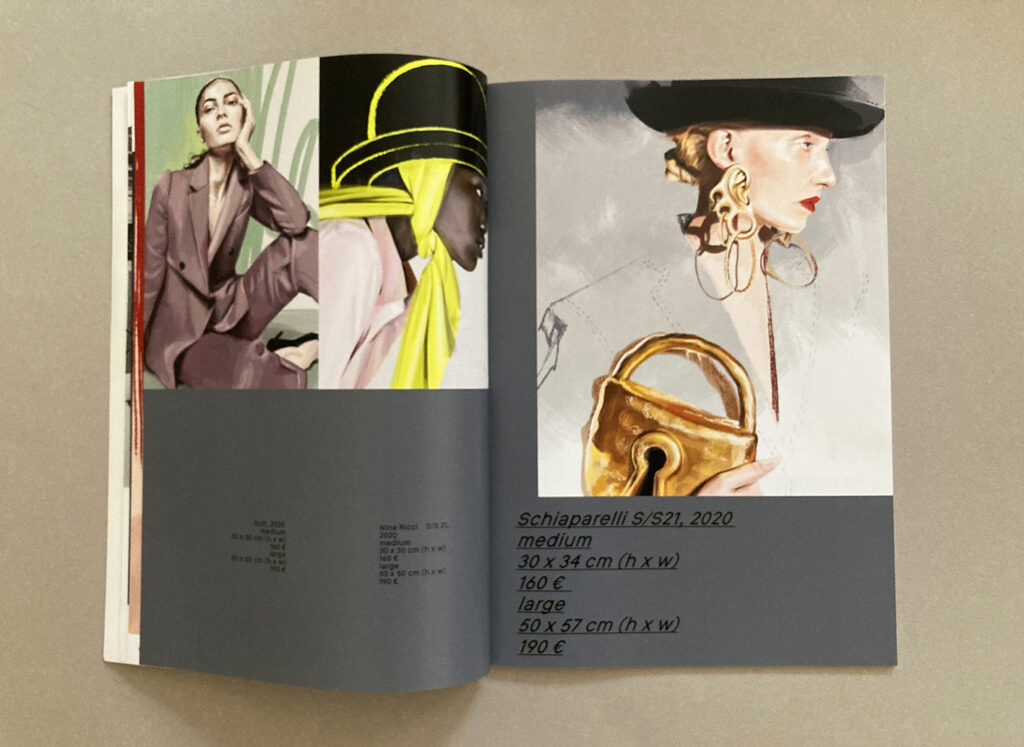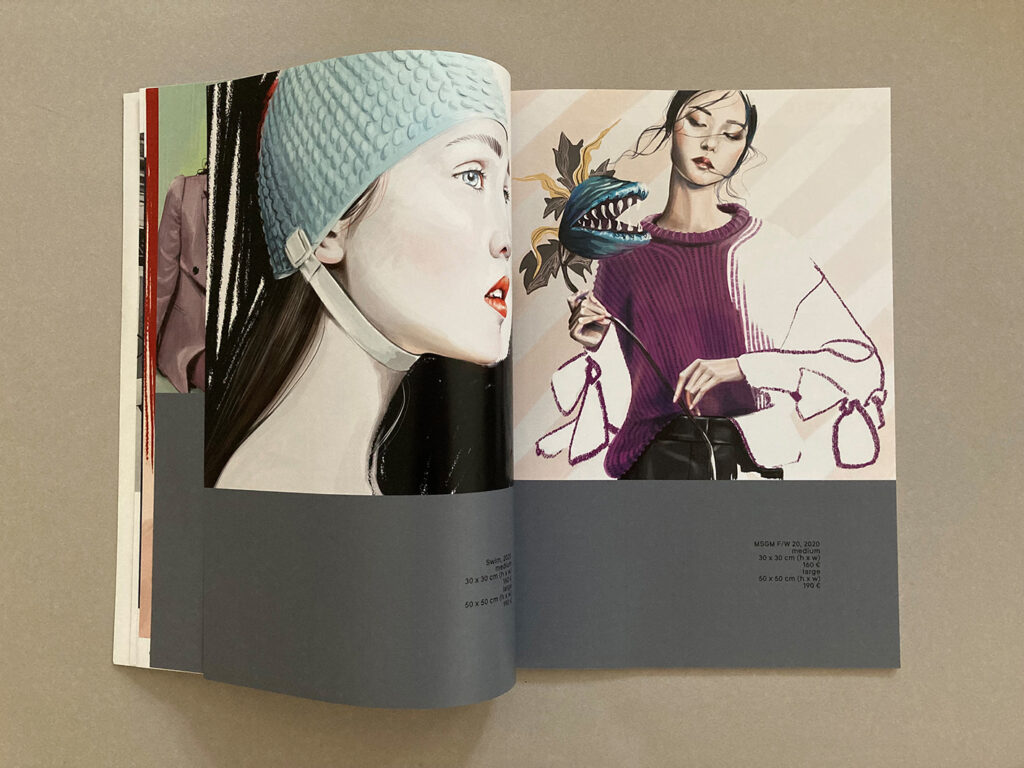Last year I showed some of my fashion illustrations as part of the exhibition “The Power of Fashion Strokes”. The Berlin HAZEGALLERY presented the work of myself and seven other fashion illustrators in a virtual exhibition from February 5 to 27.
In addition to the beautiful exhibition catalog, an extensive interview was created in which I was able to give many insights into my background and my approach.
You can find the entire interview here. Have fun reading!
Hello Anja! Thank you for taking the time for this interview. As I read in your biography, you were initially interested in fashion and then started studying fashion illustration at the Fashion Institute of Technology in New York. Ist that correct? Can you please tell us how you started your career in the arts?
Drawing and painting were already an important part of my fashion design studies in Germany. But when I came to FIT in New York, I saw a completely different level of illustration in terms of quality, technique and approach. Nevertheless, it took a few years before I decided to make a living from fashion illustration. Through my job as a fashion designer, I had gathered a number of contacts over the years and began to approach them with my portfolio. For the first two years, I worked on jobs in the evenings or at weekends. For me, it was a good opportunity to make the transition from a secure permanent position to freelance work.

Please tell us about your life in New York? Why did you decide to move back to Germany?
I was able to go to New York as a Fulbright Scholar, which is an incredible opportunity for students of all majors because you can focus entirely on your studies while Fulbright covers most of the costs and helps organize your time abroad. It was a very formative time for me in particular, as I was surrounded by a wealth of new impressions. I think NY can be pretty overwhelming when you first come to the city, but it allows you to find a niche for almost any obsession or interest, and that intrigued me from the beginning. During my time in NY, I had the freedom to try out a lot – different internships at fashion labels, illustration classes with great teachers, parties and exhibitions and lots of new people. After a year and a half, I received a job offer from a German fashion label that I was very interested in and thought it was a good time to start a new chapter.
Do you remember your first collaboration with a major fashion brand? How was it? How did they find you or vice versa?
The first big fashion brand that approached me was Hugo Boss. They came across my website during their research and asked me if I was available for a live sketching session. This request was a real turning point for me, as it opened up the field of live illustration to me. It was like jumping in at the deep end, having to draw live in front of so many people within a limited time frame. But the fact that I had to put myself under pressure and received good feedback gave me a lot of self-confidence.

Please tell us about your work with global companies such as Hugo Boss, Louis Vuitton, Olympus or H&M.
My experience of working with global companies so far has been consistently good. They usually send very detailed briefings that contain all the necessary information, from descriptions, colors and materials to sample images. This makes it easier to tackle a new project. Especially when working with these brands at live events, they leave a lot of details to me and we discuss what will give the best result.
In your opinion, is training important for an artist? I see you’ve studied a lot, right? Some people say that education sets strict boundaries, but the process of creating knows no rules. So is talent an innate gift or can it be learned?
I believe that talent and education are the two most important ingredients for a creative career. A good dose of talent is probably an important prerequisite, but without training it remains useless.
Of course, academic training is not a prerequisite, but it is a good opportunity to learn different techniques and to place your own creativity in a cultural context. Having an educational background does not mean that you are limited to certain procedures. It’s all about the basic knowledge that helps you develop your own voice as an artist.
We live in the age of social media, where self-promotion and PR are very important. Can you give young artists a few tips on how to present themselves and find the right contacts in this field?
Social media is like a double-edged sword. On the one hand, they offer us artists wonderful opportunities to promote ourselves and show the world our work, but on the other hand, the competition has never been greater and artists have become very comparable on a global level. I believe that continuity and consistency are a very important factor. They help to develop an artistic voice and style.
I would recommend every young artist to put together an online portfolio of their best work. Once you have that, you can start approaching potential clients such as art directors or brands. I know that this is not always easy, because not everyone is a natural when it comes to self-expression. But it’s worth jumping over your own shadow and making your work known, and even if you don’t get a job offer straight away, any feedback can be a good lesson.
In the beginning, every little job can help you develop and train your skills. Knowing how long you need for a drawing and what information you need from a briefing is more than helpful when it comes to a larger job.

There is currently a strict lockdown in Berlin. Has the pandemic situation affected your work and how are you dealing with it?
My working life is the part that has been least affected by this pandemic. I’m used to sitting alone in my home office studio. Of course, there is less input from real life at the moment, which is why my attention has shifted a lot to social media over the past year. I’m not always happy about this fact, but I still see the opportunity to network with other artists via social media, especially at this time, as a great gift.
Please tell us something about your artistic language. Why did you choose fashion illustration? What is your favorite technique to work with?
Maybe it’s the other way around and fashion illustration has found me. It’s what comes out of me naturally. I started sketching the models from my mother’s magazines as a child. When I studied fashion design, drawing lookbooks was always the part that interested me the most, and to this day I am fascinated by the way people express themselves through fashion.
I love sketching with ink and fineliners. But when I started working on larger jobs a few years ago, I quickly moved to digital illustration because it’s much easier to customize sketches and color schemes and make suggestions to the client.
I’m now really enjoying digital sketching and trying to experiment more with different brushes and textures. My most recent works reflect this. But I will always be drawn to traditional mediums like watercolor, pencil and ink. Firstly, because they are intrinsic to live sketch events, and secondly, because they have their own magic and challenges. An ink line cannot be removed.

Do you have certain routines or rituals when you work? What role does the atmosphere in the workplace play?
I usually try to do the administrative things first, such as writing quotes, answering emails or paying invoices, before I get creative. I’ve recently started making a short sketch every day before I start working on a project.
I often envy friends who sit in a big office and have colleagues, but I’ve realized that I can work more efficiently when I’m all alone in my studio. I like to listen to music or podcasts while I draw. That’s the perfect symbiosis.
Tell us about your future plans and your current projects. Which project or exhibition are you particularly proud of and why?
I enjoy almost all of the projects in one way or another, and I’m proud of most of them. During the pandemic, I received tons of portrait requests and I lost count of how many I did. The feedback from these customers was often overwhelming. But it feels like a bit of a superpower to know that you have the ability to make someone really happy with your skills.
For the coming year, I have resolved to work more on the symbiosis of digital and traditional drawing. And of course I’d be over the moon if I could start doing live illustration events again, because that’s one of the parts of my job that I really enjoy.
How do you see the art world and the perception of art in 5-10 years? Perhaps new movements or changes?
After what I am experiencing at the moment, it has become impossible to predict what the world will look like in the near future. It even seems impossible to keep up with the present.
I’m just convinced that art, illustration or any other form of creative expression will become more important in the face of digitalization. In a world that is increasingly determined by computers and algorithms, people have a longing for “handmade” and valuable content that has a soul.


